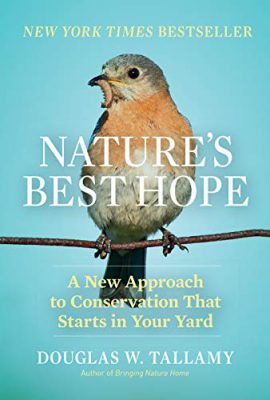Drought-tolerant yard project: Researching, planning, digging & planting
Posted on October 7, 2020 at 6:00 am
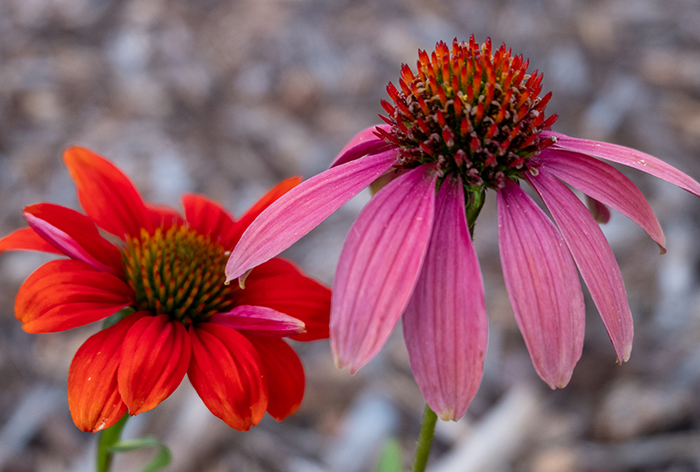
By Jane Baker
I didn’t mow the front yard all summer.
This is just one of the benefits of installing a drought-tolerant landscape, a project I started researching in 2018 and took on in 2019. In creating a new landscape, especially one without grass, I learned a lot about plants, climate, and drainage, but the most surprising lesson this project taught me came the following year when I watched my new yard come to life.
As empty nesters, we moved into a home on a small infill lot in the Valley a couple years ago. The front yard was grass with a river rock border along the driveway and the walkway to the front door, a nice basic design. However, the young shrubs planted in the border were the kind that would quickly outgrow their space, and the yard itself was uneven adding an extra challenge when mowing.
Another home on the block has a xeriscape (drought tolerant) yard—something I’ve always been interested in. Since the concept is already part of our neighborhood, and rather than pull up the old grass to level and plant new grass, I thought xeriscape would be worth considering for low-maintenance care, with the added benefit of doing my part to conserve water.
I visited the Master Gardener booth at a home & garden event in the fall of 2018, asking for information about xeriscaping, and picked up a brochure about SpokaneScape, a guide to water-wise landscaping in the Inland Northwest. This step-by-step guide laid out the entire process in an easy to follow manner.
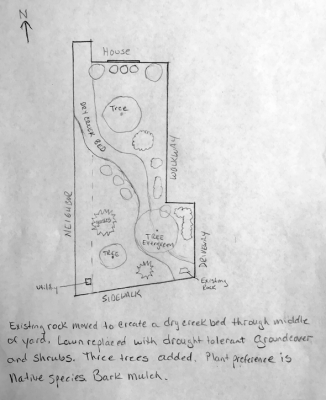
That winter, I went into planning mode, drawing out a diagram of the front yard and reading up on low-maintenance, drought-resistant, and native plants. By spring, armed with a hand-drawn plan approved by my homeowner’s association and fluorescent lines painted on the grass by the utility locaters, we rented a sod-cutter and got to work.
To reuse the river rock in the border, the main feature of the design became a dry creek bed inspired by a walk along the Centennial Trail. We cut a meandering path out of the yard and rented a rototiller to help dig down a few inches into the rocky Valley soil. After we put a weed barrier down, the rocks from the border were moved to the newly excavated area and the dry creek bed was done.
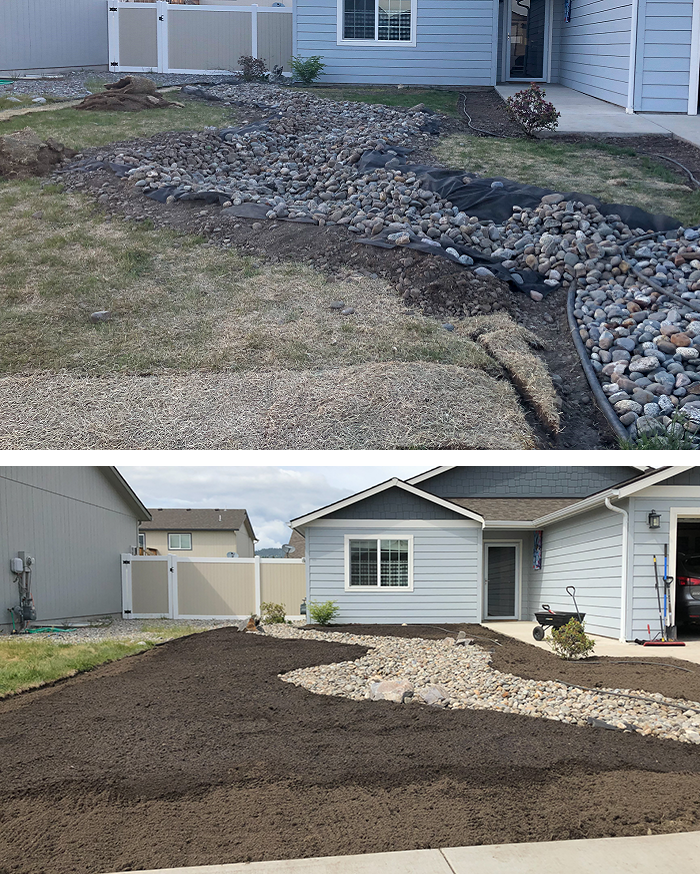
To avoid removing all the sod, we used the sheet-mulch comprised of cardboard, compost, garden soil, and bark mulch layered on top of the sod. This saved the work of removing the sod, along with the cost of disposal. Additionally, this method takes advantage of the nutrients in the sod from previous fertilizers. At this point, it was up to earthworms and time to decompose the sod.
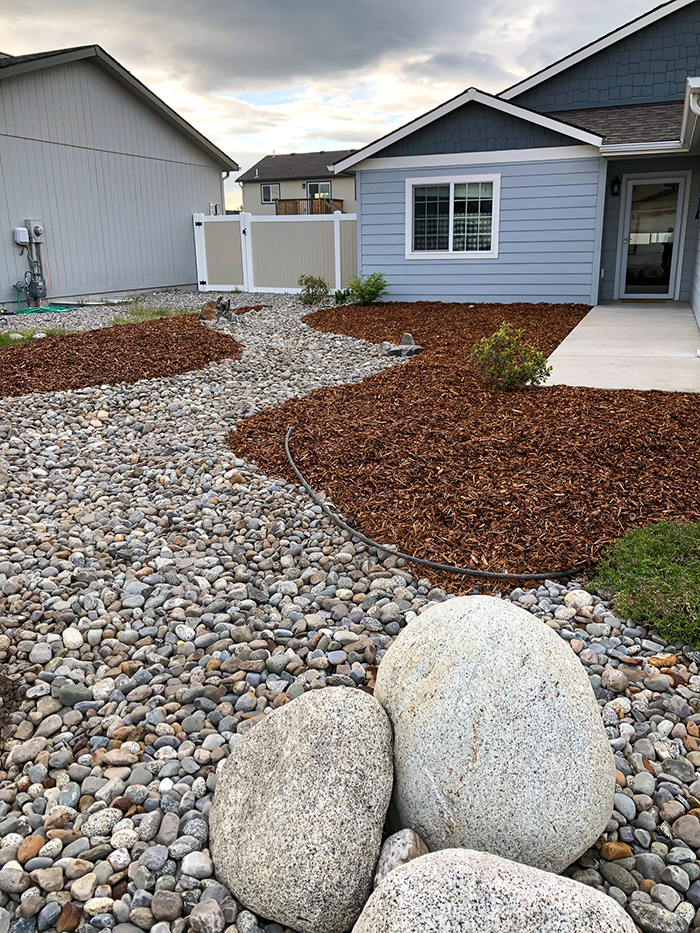
About a month later, I began planting a selection of drought-tolerant and native species plants. Again drawing inspiration from the Centennial Trail, this was a mix of trees, shrubs, perennials, and ground cover. The SpokaneScape Guide includes lists of drought-tolerant plants, and the WSU Extension Master Gardener program offers numerous resources that were super helpful in choosing this selection.
Reflecting back on it now, I realize the good fortune in having a drip line already as part of my irrigation system. All that I needed was some tubing and a few more drips to run water to each individual plant. Also, the three large boulders from the original landscape were incorporated, in place, into the new design. This saved a lot of time and the cost of attempting to move them.
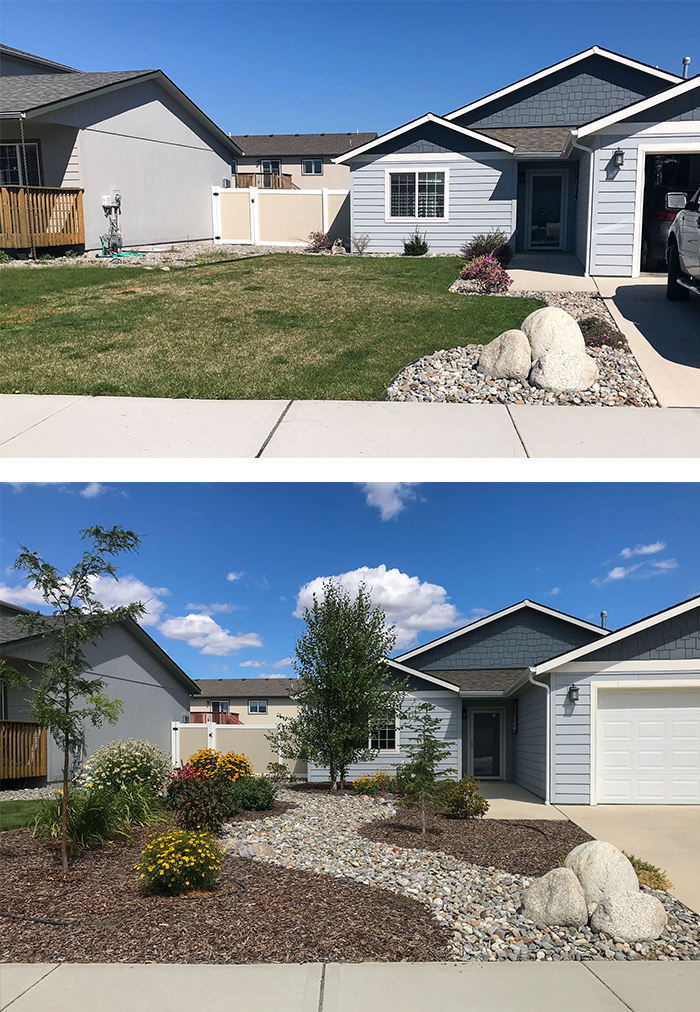
By mid-summer of 2019, most all of the planting was done, and I was pleased with how it looked. Since everything is low maintenance, there was nothing left to do until the next spring. Early in the 2020 spring season, I cut back the perennials, turned on the irrigation system, and waited to see what would happen.
Quite serendipitously, I checked out the book Nature’s Best Hope: A New Approach to Conservation the Starts in Your Yard, by Douglas Tallamy. While reading the book, I wish it had been published before I took on this yard project (it was released in February 2020). The book talks about homeowners planting more native plants and less grass to create sort of national park outside your window. Tallamy presents that if enough homeowners did this, then conservation corridors could be created to connect parks and green spaces already set aside in communities.
Tallamy believes that nature should be more than a preserved space to travel to for a visit and that nature should also be right outside our doors—humans coexisting with nature rather than delegating it to a reserved space. This approach benefits native plants, native insects, birds, animals, and ultimately, humans. Even if you have no intention of pulling up your grass and planting native plants, I recommend Tallamy’s book as a different perspective when looking at the world.
With this new perspective, I watched my front yard sprout, grow, and blossom, but the most surprising benefit has been the life that came to the yard. Tallamy suggests that when you look out your window, you should see movement. By including native plants in the design, that’s exactly what I saw—furry bumblebees flitting flower to flower, hummingbirds and Tiger Swallowtail butterflies doing their pollenating business, dragonflies and ladybugs often spotted (no pun intended) around the yard. Next year, I hope to find caterpillars and more honeybees.
It is this infusion of life that is the most delightful discovery of my new front yard. I’m excited about seeing the peaceful, little national park outside my window grow and continue to come alive. I feel good in believing that I’m doing a small part in helping the community and the planet. It’s also nice to not have to mow the lawn.

Tags: drought, drought adapted, drought resistant, drought tolerant, garden, gardening, landscape, nature, xeriscape

